#mid-eighteenth century
Text

Jean-Honore Fragonard, Mountain Landscape at Sunset, c.1765
810 notes
·
View notes
Text
today's activities include listening to imagine dragons while imagining some dragons
#em is posting about temeraire#or rather. interesting crossover fics thereof...#while waiting for empire of ivory to come in at the library I have become rather invested in two very different takes on what the mid-#eighteenth century would have been like in temrerverse - boltlightning's 'windfall / landfall' and luzula's 'the flight of dragons'#anyway. Pictures Time :)
14 notes
·
View notes
Text
Unlocked Book of the Month: History, Manners, and Customs of the Indian Nations Who Once Inhabited Pennsylvania and the Neighbouring States
Each month we’re highlighting a book available through PSU Press Unlocked, an open access initiative featuring scholarly digital books and journals in the humanities and social sciences.

About our February pick:
First published by the Historical Society of Pennsylvania in 1818, History, Manners, and Customs of the Indian Nations provides an account of the Lenni Lenape and other tribes in the mid-Atlantic region, looking at their history and relations with other tribes and settlers, as well as their spiritual beliefs, government and politics, education, language, social institutions, dress, food, and other customs. The text, written by the Reverend John Heckewelder, a Moravian missionary based in Ohio and Bethlehem, Pennsylvania, includes the author’s observations, anecdotes, and advice, preserving not only his knowledge about the Indian nations in the eighteenth century but also his perspective, as a missionary and settler, on Native Americans and the often-fraught relationships between the tribes and European settlers. This version of the text, published in 1876, contains an introduction and notes by the Reverend William C. Reichel as well as a glossary of Lenape words and phrases and letters between the author and the then-president of the American Philosophical Society concerning the study of the Indian nations and their languages.
Read more & access the book here: https://www.psupress.org/books/titles/978-0-271-06701-8.html
See the full list of Unlocked titles here: https://www.psupress.org/unlocked/unlocked_gallery.html
#Pennsylvania#Pennsylvania History#PA History#Lenni Lenape#Indian#Native American#Mid-Atlantic#Atlantic#Moravian#John Heckewelder#Ohio#Eighteenth Century#Nineteenth Century#Lenape#American Philosophical Society#PSU Press#PSU Press Unlocked
2 notes
·
View notes
Text
in subjects unrelated to any movies I may or may not have very recently watched, I've decided to actually read all the way through dylan meconis's 'family man' (first attempt at it ~7 years ago didn't go that well) and I'm thus far intrigued to report that in the intervening years I have become the kind of person who really likes a lot of what is going on in that comic thus far.
#ramblings#really I ought to start a reading tag that isn't book-specific#the captain's library#<- there I did it#but YEAH the OUTFITS and the ENVIRONMENTS oh gosh oh wow#just. very well-done eighteenth-century moving-about in relation to Clothing. which always is something that I am very very into.#wigs! and lack of wigs at home at night! and luther puts up his hair differently in formal situations!#the shirts! the way stockings are drawn to fold around the ankle! academic robes!!#ariana has a fun gender going on!!#eighteenth century people not wearing Clothing Proper To Their Gender™️ is a guaranteed Em Excitement Moment. so you see.#also I hear there are going to be WEREWOLVES in here sometime so obviously I am V. KEEN ON THAT#there are Some notable design things that make me go Uhhhh in a bit worried manner but everything else so far has been good#also not excited about the fact that this comic ends mid-story and hasn't been updated for six years but Hey#it is not as if this is the first time that I go head over heels for a comic that does that (see also tf2 much to my chagrin :/ )
3 notes
·
View notes
Photo

Wentke (Gown)
Mid 18th Century
The Netherlands
Women in Hindeloopen, a town in the northern Netherlandish province of Friesland, traditionally wore this type of striking lightweight coat, called a wentke, on special occasions. Beginning in the mid-eighteenth century, wentkes were usually made of boldly patterned Indian chintzes, and contrary to the custom in the rest of Europe of confining chintz to casual and private occasions, residents of Hindeloopen elevated this exotic fabric to a formal status. The wentke was often worn with other garments of Indian cotton. (The MET)
Peabody Essex Museum (Object Number: 2012.22.15)
#wentke#gown#jacket#georgian#1730s#1740s#1750s#1760s#regional fashion#18th century#dutch#the netherlands#blue#cotton#india#chintz#peabody essex museum#popular
3K notes
·
View notes
Text
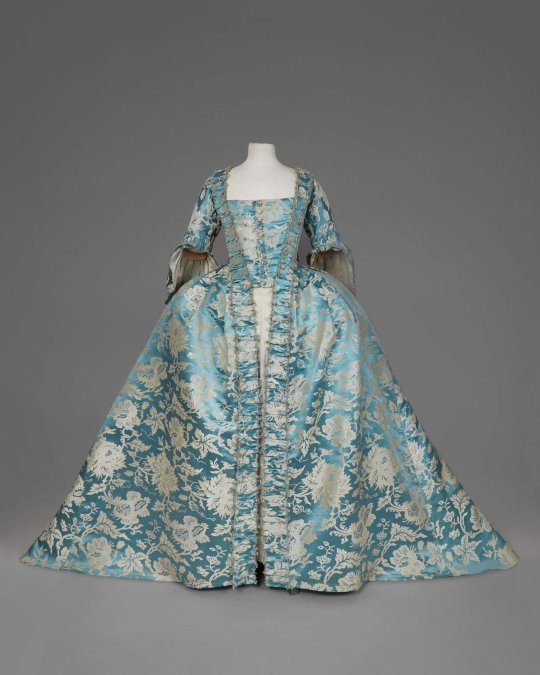

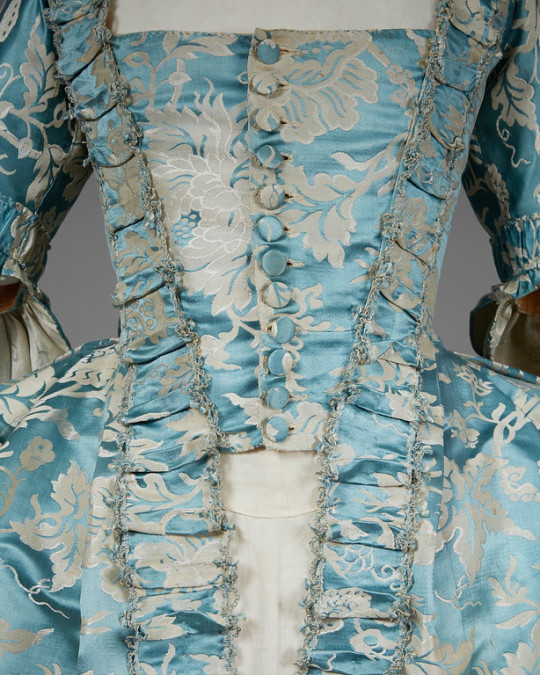

Teal Silk Brocade Mid-eighteenth Century Robe a la Francaise (Robe du Cour). Whitaker Auction Fall 2016.
767 notes
·
View notes
Text
They need to invent time travel so that I can introduce the phrase go whiteboy go to mid eighteenth century cork
181 notes
·
View notes
Text

Wooden balconies in Valletta
Malta
Small-scale wooden balconies started to appear in Valletta during the mid-eighteenth century and gradually gained popularity and became the fashion.
In reality this type of balcony was derived from North African, mostly Moroccan, prototypes which again derive from the Arabic Muxrabija (look-out place). During the rule of the Order, Malta was home to a huge number of predominantly Turkish slaves, some of whom were master craftsman who might have helped to introduce the wooden balcony to Malta.
Reposted from @guidememalta
154 notes
·
View notes
Text
when the British Empire's researchers realized that the cause of the ecological devastation was the British Empire:

much to consider.
on the motives and origins of some forms of "environmentalism".
---
Since the material resources of colonies were vital to the metropolitan centers of empire, some of the earliest conservation practices were established outside of Europe [but established for the purpose of protecting the natural resources desired by metropolitan Europe]. [...] [T]ropical island colonies were crucial laboratories of empire, as garden incubators for the transplantation of peoples [slaves, laborers] and plants [cash crops] and for generating the European revival of Edenic discourse. Eighteenth-century environmentalism derived from colonial island contexts in which limited space and an ideological model of utopia contributed to new models of conservation [...]. [T]ropical island colonies were at the vanguard of establishing forest reserves and environmental legislation [...]. These forest reserves, like those established in New England and South Africa, did not necessarily represent "an atavistic interest in preserving the 'natural' [...]" but rather a "more manipulative and power-conscious interest in constructing a new landscape by planting trees [in monoculture or otherwise modified plantations] [...]" [...].
Text by: Elizabeth DeLoughrey and George B. Handley. "Introduction: Toward an Aesthetics of the Earth". Postcolonial Ecologies: Literatures of the Environment, edited by DeLoughrey and Handley. 2011.
---
It is no accident that the earliest writers to comment specifically on rapid environmental change in the context of empires were scientists who were themselves often actors in the process of colonially stimulated environmental change. [...] As early as the mid-17th century [...] natural philosophers [...] in Bermuda, [...] in Barbados and [...] on St Helena [all British colonies] were all already well aware of characteristically high rates of soil erosion and deforestation in the colonial tropics [...]. On St Helena and Bermuda this early conservationism led, by 1715, to the gazetting of the first colonial forest reserves and forest protection laws. On French colonial Mauritius [...], Poivre and Philibert Commerson framed pioneering forest conservation [...] in the 1760s. In India William Roxburgh, Edward Balfour [...] ([...] Scottish medical scientists) wrote alarmist narratives relating deforestation to the danger of climate change. [...] East India Company scientists were also well aware of French experience in trying to prevent deforestation [...] [in] Mauritius. [...] Roxburgh [...] went on to further observe the incidence of global drought events which we know today were globally tele-connected El Nino events. [...] The writings of Edward Balfour and Hugh Cleghorn in the late 1840s in particular illustrate the extent of the permeation of a global environmental consciousness [...]. [T]he 1860s [were] a period which we could appropriately name the "first environmental decade", and which embodies a convergence of thinking about ecological change on a world scale [...]. It was in the particular circumstances of environmental change at the colonial periphery that what we would now term "environmentalism" first made itself felt [...]. Victorian texts such as [...] Ribbentrop's Forestry in the British Empire, Brown's Hydrology of South Africa, Cleghorn's Forests and Gardens of South India [...] were [...] vital to the onset of environmentalism [...]. One preoccupation stands out in them above all. This was a growing interest in the potential human impact on climate change [...] [and] global dessication. This fear grew steadily in the wake of colonial expansion [...]. Particularly after the 1860s, and even more after the great Indian famines of 1876 [...] these connections encouraged and stimulated the idea that human history and environmental change might be firmly linked.
Text by: Richard Grove and Vinita Damodaran. "Imperialism, Intellectual Networks, and Environmental Change: Origins and Evolution of Global Environmental History, 1676-2000: Part I". Economic and Political Weekly Vol. 41, No. 41. 14 October 2006.
---
Policing the interior [of British colonial land] following the Naning War gave Newbold the opportunity for exploring the people and landscape around Melaka […]. Newbold took his knowledge of the tropical environment in the Straits Settlements [British Malaya] to Madras [British India], where he earned a reputation as a naturalist and an Orientalist of some eminence. He was later elected Fellow of the Royal Society. Familiar with the barren landscape of the tin mines of Negeri Sembilan, Newbold made a seminal link between deforestation and the sand dune formations and siltation […]. The observation, published in 1839 […], alerted […] Balfour about the potential threat of erosion to local climate and agriculture. […] Logan brought his Peninsular experience [in the British colonies of Malaya] directly within the focus of the deforestation debate in India […]. His lecture to the Bengal Asiatic Society in 1846 […] was hugely influential and put the Peninsula at the heart of the emerging discourse on tropical ecology. Penang, the perceived tropical paradise of abundance and stability, soon revealed its vulnerability to human [colonial] despoilment […].
Text by: Jeyamalar Kathirithamby-Wells. "Peninsular Malaysia in the Context of Natural History and Colonial Science". New Zealand Journal of Asian Studies 11, 1. June 2009.
---
British colonial forestry was arguably one of the most extensive imperial frameworks of scientific natural resource management anywhere [...]. [T]he roots of conservation [...] lay in the role played by scientific communities in the colonial periphery [...]. In India,[...] in 1805 [...] the court of directors of the East India Company sent a dispatch enquiring [...] [about] the Royal Navy [and its potential use of wood from Malabar's forests] [...]. This enquiry led to the appointment of a forest committee which reported that extensive deforestation had taken place and recommended the protection of the Malabar forests on grounds that they were valuable property. [...] [T]o step up the extraction of teak to augment the strength of the Royal Navy [...] [b]etween 1806 and 1823, the forests of Malabar were protected by means of this monopoly [...]. The history of British colonial forestry, however, took a decisive turn in the post-1860 period [...]. Following the revolt of 1857, the government of India sought to pursue active interventionist policies [...]. Experts were deployed as 'scientific soldiers' and new agencies established. [...] The paradigm [...] was articulated explicitly in the first conference [Empire Forestry Conference] by R.S. Troup, a former Indian forest service officer and then the professor of forestry at Oxford. Troup began by sketching a linear model of the development of human relationship with forests, arguing that the human-forest interaction in civilized societies usually went through three distinct phases - destruction, conservation, and economic management. Conservation was a ‘wise and necessary measure’ but it was ‘only a stage towards the problem of how best to utilise the forest resources of the empire’. The ultimate ideal was economic management, [...] to exploit 'to the full [...]' and provide regular supplies [...] to industry.
Text by: Ravi Rajan. "Modernizing Nature: Tropical Forestry and the Contested Legacy of British Colonial Eco-Development, 1800-2000". Oxford Historical Monographs series, Oxford University Press. January 2006.
---
The “planetary consciousness” produced by this systemizing of nature [during the rise of Linnaean taxonomy classification in eighteenth-century European science] […] increased the mobility of paradise discourse [...]. As European colonial expansion accelerated, the homogenizing transformation of people, economy and nature which it catalyzed also gave rise to a myth of lost paradise, which served as a register […] for obliterated cultures, peoples, and environments [devastated by that same European colonization], and as a measure of the rapid ecological changes, frequently deforestation and desiccation, generated by colonizing capital. On one hand, this myth served to suppress dissent by submerging it in melancholy, but on the other, it promoted the emergence of an imperialist environmental critique which would motivate the later establishment of colonial botanical gardens, potential Edens in which nature could be re-made. However, the subversive potential of the “green” critique voiced through the myth of endangered paradise was defused by the extent to which growing environmental sensibilities enabled imperialism to function more efficiently by appropriating botanical knowledge and indigenous conservation methods, thus continuing to serve the purposes of European capital.
Text by: Sharae Deckard. Paradise Discourse, Imperialism, and Globalization: Exploiting Eden. 2010.
158 notes
·
View notes
Text

Interior designer Marc Lornat stripped two centuries' worth of "improvements" from his Paris apartment - originally a mid-eighteenth-century carriage house. Here, hand-hewn beams and stone window piers endow the living room with a feeling of history. Behind the seating corner, a raised platform, carpeted in dark brown, comes into its own for small dinners - or gregarious buffets.
Rooms by Design, 1989
#vintage#vintage interior#1980s#80s#interior design#home decor#living room#sectional#ceiling beams#Paris#apartment#carriage house#modern#house plants#style#home#architecture
283 notes
·
View notes
Text

The Keepers of the Eastern Door by Robert Griffing, portraying two Mohawk warriors in the mid-eighteenth century. The Mohawk were the easternmost tribe of the powerful Iroquois Confederacy, an alliance closely involved in the Seven Years War and the American Revolution (usually fighting alongside the British). Always loved Griffing's artwork, especially his pieces depicting eighteenth c. highlanders and Native Americans.
147 notes
·
View notes
Photo

Francois Boucher, The Secret Message, 1767
643 notes
·
View notes
Text
Dress, circa 1883-1885, Scotland
Silk, cotton, linen, metal




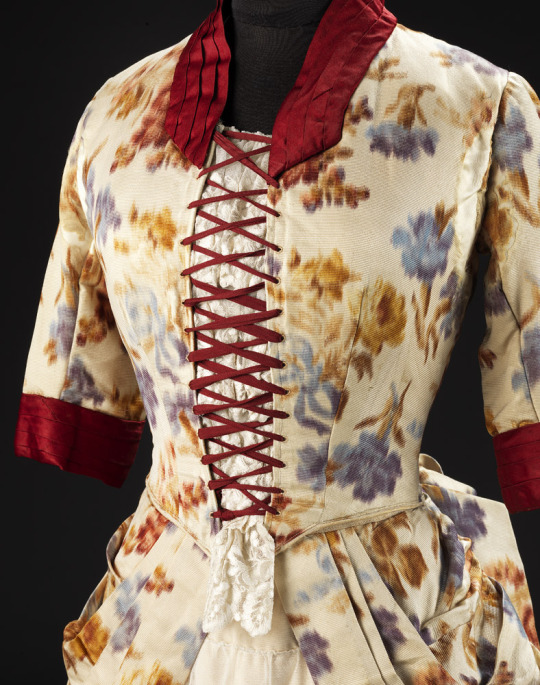


Description: Woman’s dress in cream corded silk chine printed with abstract floral design in red, blue, brown and yellow, with small, rectangular neckline with facing in pleated red silk satin, fitted bodice constructed in six panels, fastening centre front with red cord lacing through fourteen pairs of eyelets over a stomacher-style panel of horizontal cream machine lace frills. Elbow-length sleeves with pleated red silk satin cuffs. Skirt, full-length, fastening on left with five metal hooks and eyes, chine overskirt pleated into waistline at front and over hips at side, side panels trimmed with vertical border of cream machine lace and frill of cream machine lace extending into lower side edges of train, centre back cut-in-one with bodice with additional width in skirt to go over bustle, extending into a long train, red silk satin frill under hem. Petticoat-style underskirt revealed in front in cream silk satin underskirt decorated with six slightly asymmetrical horizontal rows of cream machine lace. Bodice lined in printed cotton, fitted with eight metal bones and waistband. Skirt front lined with linen and printed cotton, sides and back lined with printed cotton, integral thirteen-inch wire mesh bustle with two sets of twill weave tapes to pull fullness to back to create train, balayeuse around hem of skirt and train. Waistband printed in light green ‘R. Simpson and Sons Costumiers Jamaica St. Corner Glasgow’.
Worn by Ann Smith, the wife of Robert Kirk Simpson of R Simpson and Sons.
This romantic dress is printed with roses and has machine-lace frills on the skirt. In the 1870s and 1880s fashion looked back to the late 1700s, with its flamboyant fabrics, for inspiration. The blurred effect on this evening dress is created by printing the warp prints before the fabric is woven. This ikat technique originated in Asia and was introduced to France in the mid-1700s, where it was known as chiné. Here, it’s use, together with the laced bodice and open over-skirt draped back over the hips and into the bustle, reflect the historical revival style with its imitation of an eighteenth-century open gown.
Glasgow Museums Collection Online
78 notes
·
View notes
Text
A Working Wirtz Pump

In the mid-eighteenth century, pewterer Andreas Wirtz invented a spiral pump. Even today, his design is useful for small-scale, low-power pumping, as seen in this Steve Mould video. (Video and image credit: S. Mould)
Read the full article
90 notes
·
View notes
Note
Hello Mr Gaiman!
I’ve got a quick question about Neverwhere that I’ve been wondering for years - how old is Door?
She was born in the mid-eighteenth century our time, but time in London Below and time in London Above are out of sync, so she's not really 300 years old. In her terms she's probably not much more than 70.
625 notes
·
View notes
Text
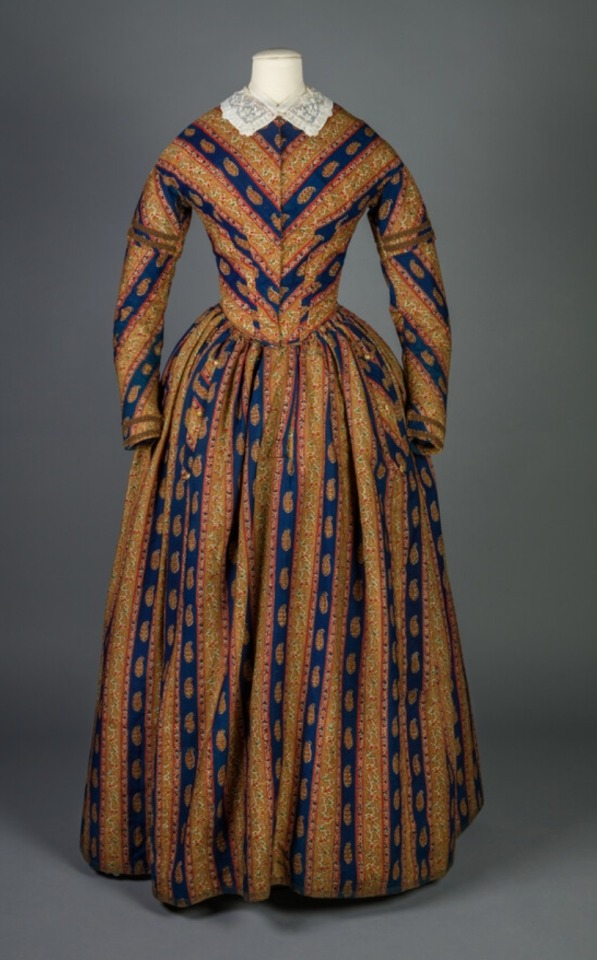
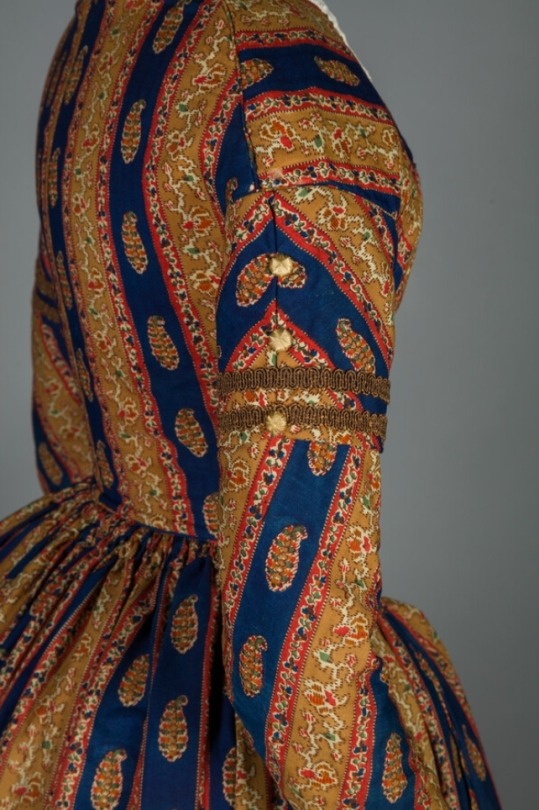

1840s
Wool printed challis dress worn by Mary Elizabeth Dorsey Farnandis (1795–1888). Fashionable paisley prints first gained popularity in the Western world during the late eighteenth century with the importation of fine goat-haired shawls from the Kashmir region of India. Nearing the mid-nineteenth century, textile manufacturers succeeded in producing paisley fabrics cheaper than those made in India, allowing entire dresses to be constructed from it.
209 notes
·
View notes